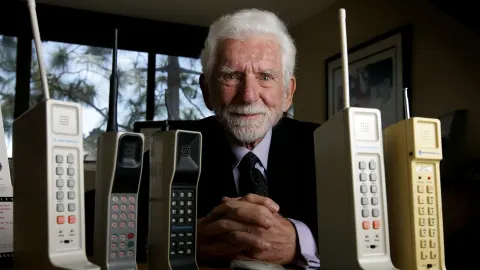50 years ago he made the first cell phone call.

New York – On April 3, 1973, Martin Cooper stood on the sidewalk on Sixth Avenue in Manhattan with a brick-sized device and made the first public call from a cell phone to one of the men he competed against to develop the device. .
“I’m calling you on a cell phone, but a real cell phone, a personal portable cell phone,” Cooper, then a Motorola engineer, told Joel Engel, head of AT&T’s Bell Labs, by phone. .
While cell phones won’t be available to the average consumer for another ten years, anyone who walks past Cooper on the street that day can witness history being made.
In the fifty years since that first call, Cooper’s bulky device has evolved to be replaced by a wide range of thinner, faster phones that are now ubiquitous and changing industries, cultures, and the way we treat each other and ourselves. But while the sheer reach and influence of cell phones may have taken some by surprise, Cooper said the possibility that cell phones would someday be considered essential to much of humanity was clear from the start.
“It didn’t surprise me that everyone has cell phones,” Cooper, now 94, told CNN. “We used to tell the story that someday, when you were born, you would be assigned a phone number. If you don’t answer the phone, you will die.”
Cell phone growth
In the months leading up to that first call, Motorola had been battling to create a cell phone with Bell Labs, the legendary research arm of AT&T that developed the transistor and other innovations.
“They were the biggest company in the world, and we were a small company in Chicago,” Cooper recalled. “They just didn’t see us as very important.”

As far as he remembers, his opponent was not as excited about the call as Cooper called him.
“You could tell I didn’t mind poking his nose into that thing. He was polite to me,” Cooper told CNN. “To this day, Joel doesn’t remember that phone call, and I don’t think I blame him.” (CNN was unable to contact Engel.)
After Cooper’s first call, he said, manufacturing problems and government regulation slowed the phone’s advance to the general public. For example, Cooper recalls the FCC, the agency for which he now serves as an advisor, trying to figure out how to split radio channels to ensure competition.
It took a decade for the DynaTAC (Dynamic Adaptive Total Area Coverage) version of this phone to hit the market for a whopping $3,900. The phone, similar to the one Gordon Gekko had in the movie Wall Street, weighed 2.5 pounds and was about a foot tall.
Compare that to the iPhone 14, which weighs 6 ounces and just under six inches, or any number of budget Android smartphones ranging from $200 to $300.
An attempt to improve the human experience
It wasn’t until the 1990s that the modern cell phone became popular as it shrank significantly in size and became much more user-friendly. According to a 2021 Pew Research Center study, 97% of Americans today own a mobile phone of some kind.
In the years since that first call, Cooper has written a book about the transformative power of the cell phone, founded companies, given speeches, and appeared in the media. But it does not necessarily cover all aspects of modern technological advances.

“Too many engineers get caught up in what they call technology and gadgets, hardware, and forget that the whole purpose of technology is to make people’s lives better,” Cooper said. “People forget about it, and I have to constantly remind them. We are trying to improve the human experience. That’s what technology is.”
However, looking back over the past 50 years, Cooper pretty much approves of where the telephone has taken us. An iPhone user himself (and before that a Samsung user), he loves to use his Apple Watch to track his swimming activity and connect his hearing aids to his phone. And Cooper said he sees the advancement of the technology as a positive for society.
“I’m an optimist. I know that the mobile phone has disadvantages. We have people who become addicted to it. We have people walking down the street talking on cell phones,” Cooper said. “Overall, I think the mobile phone has changed humanity for the better, and it will continue to do so in the future.”
Translation of the article: CNN. 50 years ago, he made the first cell phone call. By Jennifer Korn. Updated 9:13 PM EDT, Mon April 3, 2023
Original: https://edition.cnn.com/2023/04/03/tech/cell-phone-turns-50/index.html




